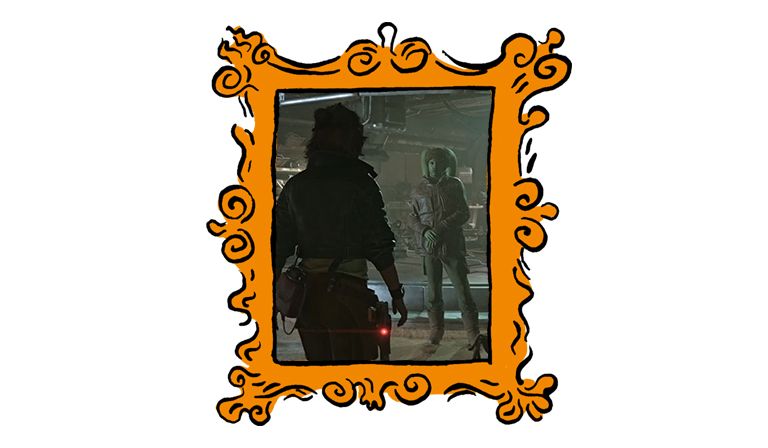I saw the future a couple of weeks ago. In Toronto. Or, more specifically, in one of those red-brick, warehouse-y office buildings that seem to litter the mile-out districts of North American cities.
This particular office belonged to Ubisoft, one of the biggest video game studios in the world, responsible for such mega-series as the Assassin’s Creed games and Far Cry. I’d been invited to try out a portion of their latest game, Star Wars: Outlaws, as well as to see a little of how they made this particular blockbuster. Me, various other journalists and a bunch of actors in body suits pockmarked by reflective dots... all in that Toronto red brick.
Who were the actors in body suits? And why? They were some of the stars of Outlaws—including the film and TV actor Humberly González, who plays the main character of the game, a rogue-ish space hustler called Kay Vess—and they were dressed so strangely because they were demonstrating the performance capture techniques that were used to make major portions of this Star Wars experience.
And so we found ourselves in a large (and largely empty) white space within the red building. This was Ubisoft Toronto’s performance capture stage, its walls kitted out with special sensors to record the movements of the dots on the actors’ costumes. González and two of her fellow performers also put on headsets that held small cameras in front of their faces. Every facet of their acting—from each twist of the mouth to sweep of the arm—would be captured and converted into raw digital information.
This wasn’t, by itself, my glimpse at the future. It was certainly impressive to see González and the other actors re-enact a scene from the game in which Vess and her space-pet Nix (a blob of fabric on the end of a broom handle, within the utilitarian confines of the performance capture stage) encounter an old compatriot and a severely malfunctioning droid.
And it was even more impressive when, on screens around the room, these physical performances were turned into rudimentary versions of their in-game equivalents—in real-time. There was Nix, both a blob of fabric on the floor and a cute little critter scuttling around on screen. There was Vess, both González in our own galaxy and a likeable scoundrel in another far, far away.
But performance capture—and its more slightly less sophisticated cousin, motion capture—isn’t really a new or surprising thing. It’s what they used to turn Andy Serkis’s gesticulations into Gollum in the Lord of the Rings movies, over 20 years ago. They’ve used it for a while in games such as the FIFA series—now called EA FC—to perfectly copy the movements of actual footballers.
No, what really struck me from the trip to Toronto was how gosh darn cinematic the process of making a game can be in 2024. Here were actors in a studio being directed through a scene. There was even a sort of virtual camera that could be wielded like a real film camera to capture the action from different angles. And that’s all before the animators get involved to turn the basic footage from the performance capture stage into the splendiferous final scenes in the game itself. We were told of how these digital artists had spent dozens of hours figuring out the look and texture of old Star Wars movies—even interviewing Hollywood cinematographers—so that Outlaws would feel as though it belonged on the same continuum.
Ah, yes, the continuum. Several years ago, for a now-deceased publication, I wrote about what I called “the Movieverse”. What I meant, in part, was something utterly prosaic: that if you want to follow cinema nowadays, then you’ve also got to pay attention to television and games. Star Wars is a clear example of this—no longer just a series of adventures on the silver screen, but also one of shows and games on our smaller screens.
But I was also getting at how the techniques of film and television and games—of moving images—are crossing over into one another. I saw this in Technicolor in Toronto, but it’s clear elsewhere and in different directions. The games of Hideo Kojima, one of the heroes of the Movieverse, appear to be made increasingly as movies—his forthcoming Death Stranding 2 will feature pretty lifelike incarnations of stars Léa Seydoux, Elle Fanning and even the Mad Max director George Miller. (It was Miller who once said, when discussing the current limitations of de-ageing effects in movies, “Everyone is on the verge of solving it, particularly Japanese video-game designers…”) Meanwhile, the Star Wars television shows have been using the Unreal game engine—effectively a software platform for making games—for their special effects sequences.
It’s the future of this terrain that’s particularly exciting—and potentially even empowering. After all, there’s a case to be made that games are movies that turn their viewers into directors. You have choices over what to see and what to do. Shot composition, story progression, pacing… all are, almost secretly, in your purview. Now imagine what could happen when advancements in virtual reality and artificial intelligence are stirred into the mix. It doesn’t take too many mental leaps to arrive at a version of 1977’s original Star Wars that allows you to walk around its sets, pick up lightsabers, see things afresh from a certain point of view.
The Movieverse won’t be all-encompassing, nor should it be. There will always be a place for games that look and play like, well, games—pixels and sprites bouncing around the screen. And who on Earth would want to mess with the exquisitely authored cinema of, say, Ingmar Bergman?
But let’s leave such questions and quibbles for future editions of this newsletter. In the meantime, and since my trip to Toronto, Star Wars: Outlaws been released on PlayStation, Xbox and PC—so you can see something of the future yourself.
The great cinematic crossover event is coming
In a galaxy not so far, far away, movies are becoming games and games are becoming movies. Where will it all lead?
September 05, 2024











